
Italian postcard. Photo: Cines. Publicity still for Quo vadis? (Enrico Guazzoni, 1913). Caption: The death of the gladiator. This image cites Jean-Léon Gérôme's famous painting 'Pollice verso' (Thumbs down, 1872) and was often used in the publicity for the film. In the back, the emperor Nero (Carlo Cattaneo) makes the sign of thumbs down, a sign for the conqueror to kill his adversary. Flanking Nero are left Tigellinus (Cesare Moltroni) and right Petronius (Gustavo Serena). Left of the imperial box the Vestal Virgins are seated.
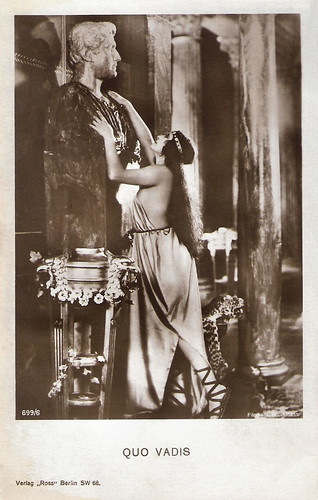
German postcard by Ross-Verlag, Berlin, no. 699/6, 1919-1924. Photo: Filmhaus Bruckmann. Rina de Liguoro in Quo vadis? (Gabriellino D'Annunzio, Georg Jacoby, 1924).

Italian postcard by A. Mondadori, Verona. Photo: MGM. Publicity still for Quo Vadis (Mervyn LeRoy, Anthony Mann, 1951). Caption: In Rome, Italy, Technicolor cameras film a scene for M.G.M.'s Quo Vadis. Roman soldiers parade before Nero's palace here.
Meanwhile, the city of Rome starts to burn…
The French translation of the novel 'Quo vadis?' appeared in 1900, and the following year Pathé produced the first cinematographic adaptation, Quo vadis? (Ferdinand Zecca, 1901).
From a Pathé catalogue (March 1902): "'Quo vadis?' is certainly one of the greatest literary successes of our time. This work has been translated into every language and printed in millions of copies. It is a novelty, so to speak, which we cannot allow to escape us. To try and adapt the whole book would be pretentious and impossible; so we have selected the most interesting scenes and arranged them in one film."
Actually, the director Ferdinand Zecca compressed the first part of the novel into one single take depicting two major scenes: the feast of Nero and the burning of Rome. Considered lost for many years, an almost complete print was rediscovered and preserved by CNC Archives Françaises du Film, and first shown in 2016 at Cinema Ritrovato within the framework of the Antiquity and Early Cinema workshop which Ivo Blom, Maria Wyke, and others organised.
The visitors of the imperial banquet are treated to a gladiator fight, in which the popular 1872 painting 'Pollice Verso' by Jean-Léon Gérôme is partly re-enacted. The same painting was explicitly cited in the 1913 version of Quo Vadis? as well as two other paintings by Gérôme: 'The Christian Martyrs’ Last Prayer' and 'Ave Caesar'.
'Pollice verso' would also be the starting point for Ridley Scott’s epic Gladiator (2000). Then, when in the 1901 version Vinicius becomes too pushy towards Lygia, the strongman Ursus enters and abducts her. Meanwhile, the city of Rome starts to burn… Despite the rash reduction of the novel, Zecca’s film version was shown for a few years around the globe.

German-Polish postcard by Verlag A. Raczynski, Krakow, 1906 / Farbenlichtdruck Martin Rommel, Stuttgart, no. 6. Artwork: Piotr Stachiewicz, 'The banquet at Nero's'. The first illustrations of Stachiewicz's work appeared in magazines from 1896 onward, while postcards were reissued many times between 1900 and 1930. He was the favourite illustrator of the novelist Henryk Sienkiewicz.
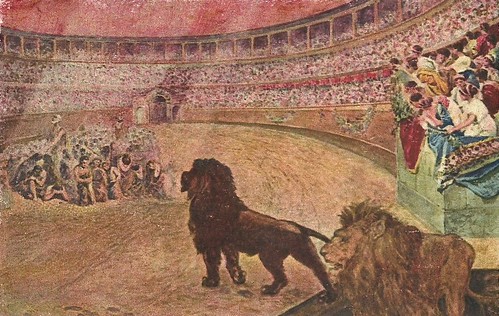
Italian postcard Ed. E. Sborgi, Firenze. Artwork: A. Del Senno, 'Cristiani al martirio'. The composition is a mirrored version of Jean-Léon Gérôme's painting 'The Christian Martyrs' Last Prayer'.
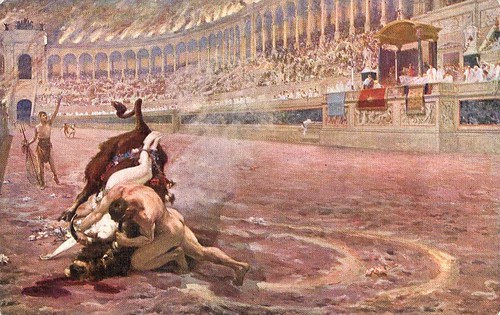
French postcard by J. Lapina & Cie, Paris, no. 25. 311. Artwork: Jan Styka, 'Quo vadis? (Ursus' battle with the bull)'. The French editor Flammmarion commissioned Jan Styka to design 150 etchings for a three-part deluxe edition (1901-1903) of the novel 'Quo vadis?'. A large postcard series was derived from this.

Polish postcard by ed. Krakow 1903. Publicity still of a Polish stage version of 'Quo vadis?'. Lygia pleas Ursus not to kill Vinicius. On the left, the dead gladiator Croton, who was supposed to kill Ursus, while Vinicius would abduct then Lygia. On the right, the treacherous Chilon observes the scene.

British postcard in the Opalette Series by Rotary Photo E.C., no. O.3077.A. Australian actress Mab Paul as Lygia in a British stage play version of 'Quo vadis?' based on the novel by Henryk Sienkiewicz. As Paul left the UK in 1910 to head back to Australia, this might be a pre-1910 card.

French postcard. Photo: J. Bioletto, Lyon. Jean Riddez as Vinicius in the opera 'Quo vadis?' (1909) by Jean Nouguès, libretto by Henri Cain.

Austrian postcard, no. 6. Photo: Ludwig Gutmann, Vienna, Sept. 1910. Maria Jeritza as Lygia and Theodor Schütz as Vinicius in the opera 'Quo vadis?' at the Wiener Volksoper 1910.
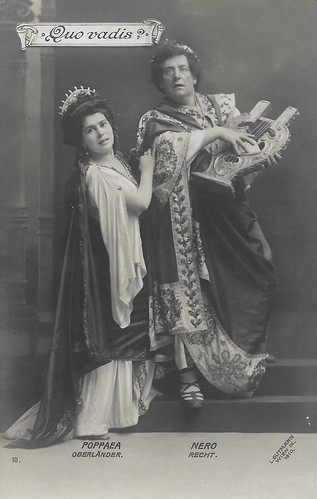
Austrian postcard, no. 10. Photo: Ludwig Gutmann, Vienna, Sept. 1910. Mr. Recht as Nero and Helene Oberländer as Poppaea in the opera 'Quo vadis?' at the Wiener Volksoper 1910.

French postcard by A.N. (Armand Noyer), Paris, no. 276/3. Sculptography: Domenico Mastroianni, 1913.

Belgian postcard by Ed. A. Deloga, Bruxelles. Photo: Cines. Publicity still for Quo vadis? (Enrico Guazzoni, 1913). On 18 July (year unknown) the Brussels cinema Majestic, 62, Boulevard du Nord (now Boulevard Adolphe Max), re-released the Italian silent epic Quo vadis? (Enrico Guazzoni, 1913) because, as the postcard says, of general demand. The film took 2 hours, which was quite long for those years, and was shown integrally, with a new musical score. The still depicted is a citation from Jean-Léon Gérôme's well-known painting 'The Christian Martyr's Last Prayers' (1883). It was much recycled in the publicity for the film, on posters, in brochures, and in advertisements in magazines.
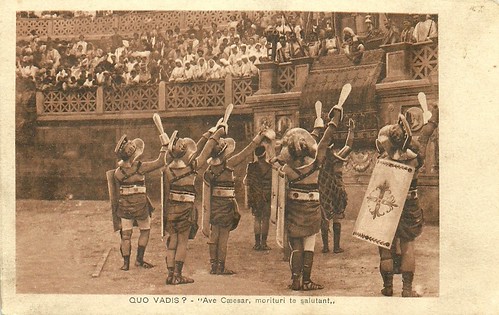
Italian postcard. Photo: Cines. Publicity still for Quo vadis? (Enrico Guazzoni, 1913). Caption: "Ave Caesar, those who are about to die, salute you."
This image cites a famous 19th-century painting (1859) by Jean-Léon Gérôme. It was often quoted, also in the Asterix comics, see Asterix the gladiator.
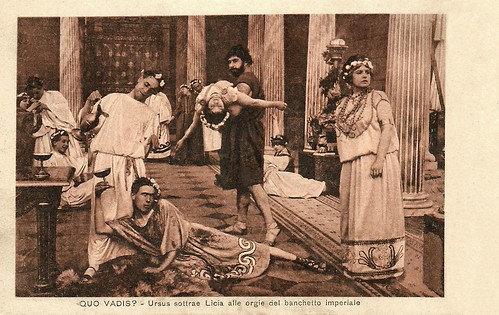
Italian postcard by Uff. Rev. St. Terni. Photo: Cines. Publicity still for Quo vadis? (Enrico Guazzoni, 1913). Helped by Acte, Nero's former mistress, Ursus (Bruto Castellani) subtracts Lygia (Lea Giunchi) from the orgy of the imperial banquet, where the drunken Roman Vinicius tries to rape her.
The Start of Hollywood on the Tiber
Ferdinand's Zecca’s 1901 film was part of a Quo vadis?-mania. The book itself, which had its original release as a feuilleton in 1895 and as a novel in 1896, was translated into over 50 languages and contributed to Henryk Sienkiewicz's Nobel Prize for literature in 1905.
In 1900 a stage version would be organised by Stanislaus Stange, which soon spread all over the Western world. Moreover, in 1909 an opera version came along, composed by Jean Nouguès with a libretto by Henri Caïn. This was also performed all over Europe, including at the Wiener Volksoper in 1910.
Several illustrated postcard series were issued in the 1900s, 1910s, and 1920s by reputed artists such as Jan Styka, Piotr Stachiewicz, and Domenico Mastroianni. Sometimes these quoted Gérôme again like the Italian Del Senno did with 'The Christian Martyrs’ Last Prayer'.
Several films have been based on 'Quo vadis?', including two Italian silent films in 1913 and in 1924, a Hollywood production in 1951, a miniseries directed by Franco Rossi in 1985, and a 2001 adaptation by Jerzy Kawalerowicz.
In 1912-1913 Enrico Guazzoni directed an impressive version for the Roman company Cines, which premiered at the Roman Teatro Costanzi, the actual Roman opera house. It also had a prestigious international release with even the British Royals visiting a screening and with screenings in established theatres instead of cinemas like the Astor Theatre in New York. Italian cinema gained much prestige because of this epic and subsequent Antiquity films.
In 1924 the trust Unione Cinematografica Italiana produced a new version with Emil Jannings as Nero and many other European leading actors of the moment such as Lilian Hall-Davis and Alphons Fryland.
In 1951 the first major post-war film production at the Roman Cinecittà studio was the American production Quo Vadis? by Mervyn LeRoy and starring Robert Taylor as Vinicius, Deborah Kerr as Lygia, Leo Genn as Petronius, Marina Berti as Eunice, and Peter Ustinov as Nero. It was the start of what is called ‘Hollywood on the Tiber’, indicating the Golden Age of American cinema being shot in Italy, and actually, a phrase launched during the shooting of this film.

German postcard by Ross Verlag, no. 698/1. Photo: Filmhaus Bruckmann. Emil Jannings as Nero in Quo vadis? (Gabriellino D'Annunzio, Georg Jacoby, 1924).

German postcard by Ross Verlag, no. 698/3. Photo: Filmhaus Bruckmann. Lilian Hall-Davis as Lygia in Quo vadis? (Gabriellino D'Annunzio, Georg Jacoby, 1924).

German postcard by Ross Verlag, no. 698/4. Photo: Filmhaus Bruckmann. Alphons Fryland as Vinicius in Quo vadis? (Gabriellino D'Annunzio, Georg Jacoby, 1924).

German postcard by Ross Verlag, no. 699/3. Photo: Filmhaus Bruckmann. Alphons Fryland as Vinicius and Lilian Hall-Davis as Lygia in Quo vadis? (Gabriellino D'Annunzio, Georg Jacoby, 1924) . Here Vinicius tries to seduce the chaste Lygia during an orgy at the palace of Nero.

Italian postcard by Edizione L'Argentografica, Torino. Publicity still for the Italo-German epic Quo Vadis? (Gabriellino D'Annunzio, Georg Jacoby, 1924), starring Emil Jannings as Nero, Elena Sangro as Poppea, Alphons Fryland as Vinicius, and Lilian Hall-Davis as Licia (or Lygia).

Italian postcard by G.B. Falci, Milano, no. 155. Photo: La Fotominio. Publicity still for Quo vadis? (Gabriellino D'Annunzio, Georg Jacoby, 1924). Caption: Nero's pastimes. Nero (Emil Jannings) is seated in the back in the litter.
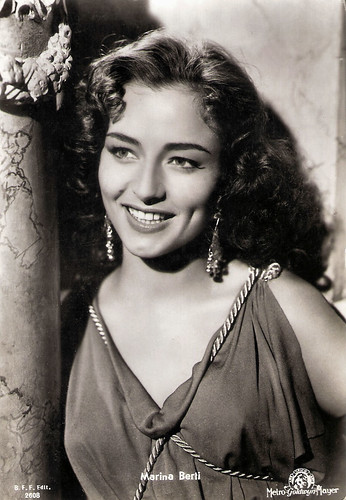
Italian postcard by B.F.F. Edit., no. 2608. Photo: Metro-Goldwyn-Mayer. Marina Berti in Quo Vadis (Mervyn LeRoy, Anthony Mann, 1951).

German brochure by Neues Film-Programm, no. 1505. Photo: Metro-Goldwyn-Mayer. Deborah Kerr and Robert Taylor in Quo Vadis (Mervyn LeRoy, 1951).

German brochure by Illustrierte Film-Bühne, no. 2295. Deborah Kerr and Robert Taylor in Quo Vadis (Mervyn LeRoy, 1951).
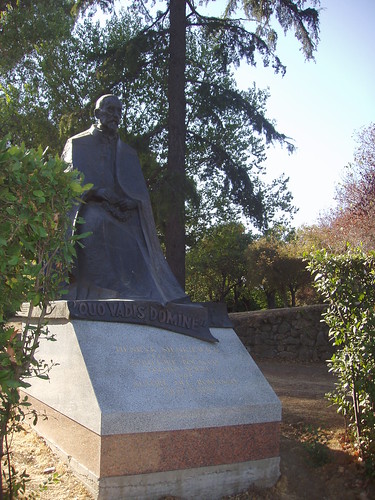
Statue of Henryk Sienkiewicz, Villa Borghese, Rome. Photo: Ivo Blom. For years only a small statue of Sienkiewicz could be found in the same corner in Villa Borghese (Piazzale Ferdousi). Now there is this giant, created by Polish sculptor Czeslaw Dzwigaj.
Text: Ivo Blom. Source: Elisabetta Gagetti & Monica Wozniak, 'Quo vadis - La prima opera transmediale' (Accademia Polacca Roma, 2017).
So glad the festival is back and looking forward to your coverage. Will link back to it from my blog.
ReplyDeleteAs for Quo Vadis, one of my all-time faves....
Thank you, Maria. Enjoy the other posts. Greetings from Bologna! Paul and Ivo
Delete